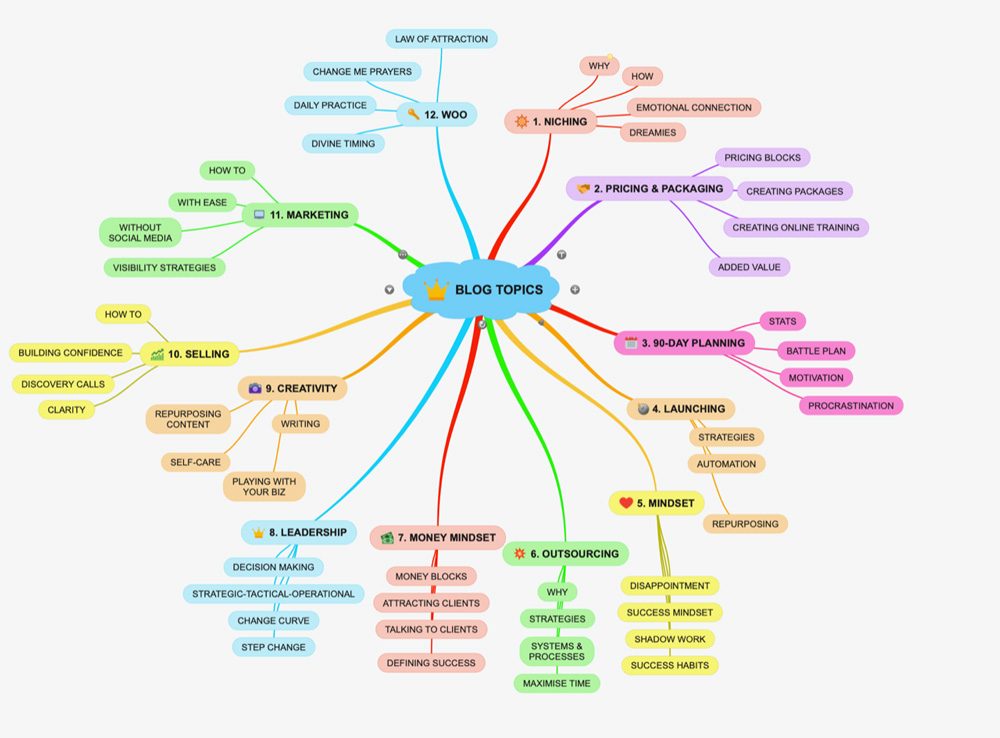Originally Posted on The Coaching Tools Company as 3 Great Tools to Add to Your Coaching Toolkit | by Ruby McGuire
Experimenting with a range of different coaching tools can add fun, depth and interest to your coaching sessions. Some fun possibilities include outdoor-based coaching, vision boards, play therapy and more. Let’s discuss three of my favourite tools to consider adding to your coaching toolkit. And they may work for your own personal and business projects too…
1. Mind mapping
I remember first learning about mind mapping when I was doing my degree in human resources. It’s the most fantastic tool. You get to use coloured pens and little images to help your brain make connections. What’s not to love?!
What is it?
So, you know what they say—a picture is worth a thousand words. Mind mapping is a brainstorming tool that lets you organize your thoughts visually.
You write a topic title in the centre of the page, then add spokes from the central point. As you think of new ideas, you add these to the spokes. See the image below for a simple example. You can go old school with a pen and paper, or use an app.
What can you use Mind Mapping for?
Mind maps help me organize my thoughts and spot patterns and connections. Here are a few ways I use them in my business:
- Writing blog posts, newsletters and articles (like the example above).
- Coming up with content ideas for online training, podcast episodes, Facebook Lives, webinars, speaking gigs, eBooks and books.
- Working 1:1 in client sessions, particularly when trying to explain a tricky concept to a client when I’m mentoring.
Why would you want to use it in a client session?
It can be challenging for clients to arrange their thoughts, particularly if there’s a big task to accomplish or they feel overwhelmed. Mind mapping is a time-saving method that allows your client to get an overview and find solutions to problems quickly.
Here are some key benefits of using the mind mapping method:
- Create connections that your client might not otherwise have seen.
- Stimulate creativity.
- Help improve memory and retention.
- Explore ideas in a flexible, non-linear manner, adding to them as new ideas are formulated.
- Save time by focusing on keywords instead of writing copious notes.
- Reduce the level of overwhelm by processing thoughts on paper.
Plus the beauty of mind mapping in a session is that you can brainstorm together and create an action plan from the ideas generated.
2. Guided Visualization
Coaching is great, but sometimes it can lead to overanalyzing and overthinking. This is where bringing in visualization can help clients make a better connection with themselves. Help them to tap into their unconscious mind instead of trying to fix something logically.
How does it work?
When you take a client through a visualization, you share mental imagery and bypass logical thinking.
How do you conduct a visualization exercise?
- Ask your client what environment helps them relax—for example, the beach, forest walks, or a spa.
- Get your client to settle into their chair and close their eyes.
- Help your client imagine being in a lush forest or on a beach with waves crashing on the sand. Speak in a quiet and calming voice.
- Describe this peaceful place they’ve chosen, building detail as you go, using the 5 senses such as sound, scents and visuals.
- Build in some quiet time where you don’t speak so they have time for their thoughts.
- After a few minutes, guide your client back to the beginning of their journey. Encourage them to open their eyes when ready.
- Spend a few minutes discussing what came up for them.
You can also get your client to tap into how they feel in this beautiful place or a particular situation. It can help them understand how they might handle difficult situations better, feeling confident, calm and in control.
And of course you can ask them coaching questions while in this calm, creative space.
Note: Keep the visualization very simple. Ideally, you’ll have completed training before running in-depth guided visualizations. If you think your client has mental health issues or isn’t in a good place, please proceed cautiously.
Why would you want to use it in a client session?
Allowing your client space to fully relax and explore ideas in a non-logical way can create solutions to problems. Use this method to:
- Help your client imagine potential scenarios and explore strategies to deal with real-life challenges.
- Help clients better understand their current situation and the possibilities or opportunities available to them.
- And we know the brain can’t tell the difference between real and imagined fear. So you can use visualization to help your client imagine and “cheat” their brain into thinking it’s already handled the tricky situation they feared—giving clients confidence and courage.
| Editor’s Note: We offer a great Calming Guided Visualisations Toolkit (with guided meditation scripts, audio recordings and user guide) plus our Peak Moment Coaching Exercise (which includes guided meditation script, instructions and optional client follow-on homework). |
3. Creative writing and journaling
Creative writing and journaling are excellent methods to help your clients tap into their creativity. With creative writing, your client will write creatively around a topic idea. In contrast, journaling is more personal and involves writing down thoughts and feelings they might be experiencing. Journaling is often reflective and can be quite cathartic. It can also be an excellent way for clients to decompress after their coaching session.
How does it work?
You can set up this practice in many ways, either within a session or as a piece of “homework.” Here are a few ideas to get you started:
- Journaling Prompts: Give your clients some thought-provoking prompts or fill-in-the-gap sentences to get their creative juices flowing. If they’re creative writing, you can give them a topic to explore. For example, they could explore their thoughts, feelings, attitudes and behaviours in a particular situation.
- Daily writing: Help your client create a daily writing practice. Choose a set time of day, and how long—for example, a few minutes a day for a week.
- Stream of consciousness: Clients can write their stream of consciousness. This is simply writing down everything that pops into their heads, no matter how minor or seemingly irrelevant.
- Short stories/ poetry/essays: Clients can creatively write in a particular form or genre, such as a poem or a haiku (a poem with 17 syllables, usually related to the natural world). It can be for fun, or even around a coaching topic or personal issue.
Why would you want to use it in a client session?
Creative writing or journaling is easy to set up when you want to switch gears in a session. It has many benefits, including:
- Self-awareness: Creative writing and journaling can help shed light on repetitive patterns of thoughts and behaviour that aren’t serving them.
- Managing mindset: Writing can be a great way to help with overwhelm, stress and anxiety. The client can feel more in control as thoughts are written down and processed. It’s a great, healthy way to manage emotions.
- Clarity: Whether creative writing or journaling, clients can have aha moments (which we know all coaches love!). Writing can also help clarify and organize thoughts, which can help with problem solving.
- Sparking new ideas: Exploration through writing can generate new ideas and connections.
- Providing a safe space: Writing allows clients to explore their innermost feelings in a safe space.
Wrap-up
Here’s a quick recap of three tools that you could consider adding to your coaching toolkit:
- Mind mapping
- Guided Visualizations
- Creative writing and journaling
Not all tools work for all clients. In short, you need to know what your clients like and dislike. If you need more clarification, ask.
In particular, a client who has only experienced ‘standard’ coaching sessions may benefit from trying more creative thinking methods.
What are your favourite coaching tools? Let us know in the comments—we’d love to hear from you.
PS. It would be remiss of me not to shout out about The Coaching Tools Company tools. They are structured journaling tools, make great homework. can be branded for your business—and save you hours of time. A no-brainer.
PPS. If you liked this, then you will love my eBook, Ruby’s Coaching Gems, where I share simple strategies and thought-provoking questions (gems) that you can use today to take your coaching business to the next level.
If you liked this article, you may also like:
The Complete Guide to Life Coaching Tools, Forms and Exercises (with examples) and:









